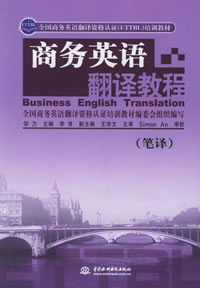Layout features of English legal documents namely "Contracts"
作者:古龙 2009-07-04




语际翻译公司 转载请注明https://www.scientrans.com
∗本栏目部分文章内容来自互联网,部分已经过本站编辑和整理,如有版权事宜请联系Email/MSN jesczhao@hotmail.com
It seems reasonable to ask first the following question: Is there a general layout that characterises such documents? In attempt to answer this question, it is worthwhile to clarify, first, what is meant by layout. Farghal & Shunnaq (1999) 1 point out that:
"Layout refers to the sketch or plan of the texts" physical appearance. This relates to paragraphing, indentation, and graphitic choices, Viz., capitalizing, italicizing, underlining and bold-typing." (p. 205-206).
In this perspective, Crystal & Davy (1986: 197) 2 proclaim that legal documents were usually made as a solid block of script whose long lines are from margin to margin and there were no patterns of spacing or indentation to indicate the limits of the paragraphs or the relation between them. It was common for draftsmen to compose an entire document in the form of one single sentence.
Another prominent characteristic of English legal texts, in what concerns layout of course, is the absence of punctuation. As it is normally known punctuation helps reading
a piece of writing loudly. But, what if legal texts are originally made to be read in silence, not to be spoken at a loud voice and hence the thinness of their punctuation. In this respect, Crystal & Davy (1986) 3 report an important aspect of legal language as:
" essentially visual, meant to be scrutinised in silence" it is, in fact, "largely unspeakable at first sight, and anyone who tries to produce a spoken version is likely to have to go through a process of repeated and careful scanning in order to sort out the grammatical relationships which give the necessary clues to adequate phrasing "(p:194).
It could be said that reading legal texts aloud was the last thing likely to happen to such texts which are supposed to be scrutinized in silence. This non-use of punctuation as claimed by Crystal & Davy (1986: 194) 4 has two other reasons: the first is the flexibility of adding or omitting its marks as an attempt for forgery. The second is the perception of the mechanics of punctuation as worthless in revealing the grammatical or logical structure of written language. However, nowadays, one can safely assume that punctuation though rare, has a function in legal texts, and this trait is clearly apparent in the document given as an example later on in this present article.
Legal language is a special language which needs a special care when dealt with because most of our common everyday activities are carried out within a legal context. So, due to this specific feature there is a tendency to make legal texts more cohesive and coherent through opting for a more consistent layout. Correspondingly, Crystal & Davy (1986: 189) 5 make the point that legal drafters start to give much attention to the graphitic and graphological devices such as capitalization, indentation, italicizing, lettering, paragraph division and so on. For the sake of illustration, let us consider the following extract of a legal English contract:
Residential Lease Agreement
THIS LEASE AGREEMENT made and entered into this ____________ day of ____________________________, 20____, BY AND BETWEEN _________________________________________________ (hereinafter referred to as "Landlord") and ______________________________________________ (hereinafter referred to as "Tenant").
W I T N E S S E T H :
WHEREAS, Landlord is the fee owner of certain real property lying and situated in _______________ County, such real property having a street address of _______________________________________________________ (hereinafter referred to as the "Premises").
WHEREAS, Landlord desires to lease the Premises to Tenant upon the terms and conditions as herein contained;
WHEREAS, Tenant desires to lease the Premises from Landlord on the terms and conditions as herein contained;
NOW, THEREFORE, in consideration of the covenants and obligations herein contained and other good and valuable consideration, the receipt and sufficiency of which is hereby acknowledged, the parties hereto agree as follows:
1. TERM. Landlord leases to Tenant and Tenant leases from Landlord the aforesaid Premises together with any and all appurtenances thereto, for a term of __________________ [specify number of months or years], such term beginning on __________________, and ending at 11:59 PM on ______________________.
2. RENT. The total rent for the term hereof is the sum of ___________________________________________________________ DOLLARS ($____________) payable on the ______ day of each month of the term, in equal instalments of ______________________________________________________________ DOLLARS ($_____________), first and last instalments to be paid upon the due execution of this Agreement, the second instalment to be paid on _______________________. All such payments shall be made to Landlord at Landlord's address as set forth in the preamble to this Agreement on or before the due date and without demand.
3. DAMAGE DEPOSIT. Upon the due execution of this Agreement, Tenant shall deposit with Landlord the sum of ____________________________________________ DOLLARS ($________) receipt of which is hereby acknowledged by Landlord, as security for any damage caused to the Premises during the term hereof. Such deposit shall be returned to Tenant, without interest, and less any set off for damages to the Premises upon the termination of this Agreement… 6
It can be inferred from the above-illustrated model that the phrase “THIS LEASE AGREEMENT” is written in capital letters as an emphasis of its importance in introducing the document. Also, the phrase “BY AND BETWEEN” is capitalised. It distinguishes the paragraph that introduces the contracting parties. In addition, both words ‘Landlord’ and ‘Tenant’ begin with a capital letter since they refer to a specific meaning with a particular content. Moreover, the word WITNESSETH is the main verb of the contract which is written in a distinct script as a means of giving much emphasis to the clause it introduces and, by the way, this verb is used in its archaic version. It means actually witnesses in the third person singular of the present tense. Also, the word WHEREAS is printed in bold typing to refer to the preamble of the contract. Finally, the phrase ‘NOW THEREFORE’ is capitalised in bold-typing as an emphasis of its importance in introducing the clauses of the contract. Concerning the rest of the contract, one can easily notice that much attention is given to punctuation.
English Legal texts, particularly, contracts have a certain layout norms adopted when they are drafted. Some of these are paragraph division, indentation, punctuation, capitalization, bold-typing, and italization etc. Each of which has a function within legal texts; their use renders these texts more cohesive and coherent. The layout of Arabic legal contracts, on the other hand, differs to some extent from that of the English contracts; even within the Arab world each country has special layout norms to be respected. This asymmetry at the level of layout between English and Arabic legal texts creates a dilemma for the translator: to keep the original layout features or to adopt those of the target language legal texts. From a translational point of view, most theorists within the field of translation recommend remaining faithful to the layout of the original legal texts; that is, to ensure that the translated version communicates the same layout features of the original. To illustrate, See the following Arabic translation of the above English legal lease contract.
عقد كراء محل سكني
حرر عقد الإيجار هذا في يوم_____من شهر__________
سنة_____________20 بين كل من____________(المشار إليه فيما بعد في هذا العقد "بالمكري")
وبين_____________________(المشار إليه فيما بعد في هذا العقد "بالمكتري").
تقرر ما يلي :
بماأن للمكري الملكية المطلقة للمحل السكني الكائن في مقاطعة __________________
هذا المحل السكني له العنوان التالي : _______________________
(المشار إليه فيما بعد في هذا العقد "بالعقار").
بماأن المكري يرغب تأجير العقار للمكتري بموجب الشروط الواردة في هذا العقد؛
بماأن أن المكتري يرغب في تأجير العقار من المكري بموجب الشروط الواردة في هذا
العقد؛
نظرا، للتعهدات والالتزامات الواردة في هذا العقد وكذلك مقابل عوض مادي معتبر
وبموجب الإقرار على الإيصال وكفايته. تم اتفاق الطرفين بموجب هذا العقد على ما يلي:
1.المدة. يأجر المكري للمكتري والمكتري يستأجر من المكري العقار المذكور أعلاه كاملا
مع ملحقاته لمدة ________________________
(يحدد عدد الشهور أو السنوات)، تبدأ هذه المدة اعتبارا من ____________________________
وحتى الساعة 59 : 11 بعد الزوال من يوم ______________________________
2.السومة الكرائية. إجمالي السومة الكرائية للمدة المذكورة تقدر بمبلغ ________________
دولار ($_________ ) واجبة الدفع في يوم_____________ شهريا_______
خلال فترة هذا العقد وبأقساط متساوية_________ دولار ($______ ) وتدفع أول
الأقساط وآخرها عند التنفيذ اللازم للعقد، والدفعة الثانية تسدد بتاريخ__________.
تدفع كل هذه الأقساط إلى المكري في عنوانه الموضح في ديباجة هذا العقد بتاريخ
الاستحقاق أو قبله دون الأمر بالأداء.
3. التأمين على الضرر. يودع المكتري للمكري، حال تنفيذ هذا العقد، مبلغ _______
دولار_____ ($_____ ) كتأمين على أي ضرر قد يلحق بالعقار أثناء فترة هذا العقد، تسترجع هذه الوديعة إلى المكتري دون فوائد أو أقلها عند المطالبة بالتعويض عن الضرر الحاصل بالعقار عند انتهاء العقد.
It is quite obvious that much care and interest are given to legal texts through the use of layout features for the sake of revealing structure, content, and logical progression as a guide to facilitate interpretation. Therefore, layout features need to be respected in any legal text submitted to translation.
来源:互联网
- 相关文章

- 没有相关文章
- 评论
- seme:文章内容文章内容文章内容文章内容文章内容文章内容文章内容文章内容文章内容 章内容文章内容文章内容文章内容文章内容
- seme:文章内容文章内容文章内容文章内容文章内容文章内容文章内容文章内容文章内容 章内容文章内容文章内容文章内容文章内容

- 商务合同英译应注意的问题(2)
2009-7-5 16:30:09 - 二、慎重处理合同的关键细目 实践证明,英译合同中容易出现差错的地方,一般来说,不是大的陈述性条款。而恰恰是一些关键的细目.比如:金钱、时间、数量等。为了避免出差错,在英译合同时,常常使用一...
- 商务合同英译应注意的问题(1)
2009-7-5 16:27:28 - 前言 英译商务合同貌似简单,实则不然。商务合同是一种特殊的应用文体,重在记实,用词行文的一大特点就是准确与严谨。 本文拟运用翻译教学中所积累的英译商务合...
- 第四届IEEE生物信息与生…
2009-6-30 19:42:01 - 基本信息 主办单位: 四川大学,IEEE生物医学工程协会(EMBS) 承办单位 开始日期 2010/06/18 结束日期 截稿日期 2009/1...
- 第九届全国光电技术学术…
2009-6-30 19:35:58 - 基本信息主办单位: 中国宇航学会光电技术专业委员会承办单位 开始日期 2009/11/01结束日期 截稿日期 2009...















